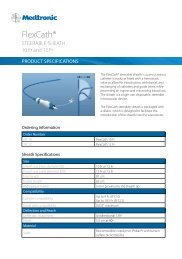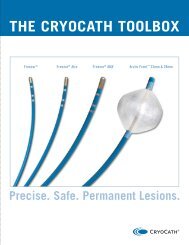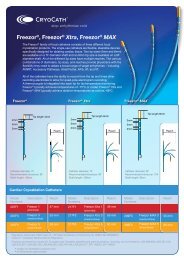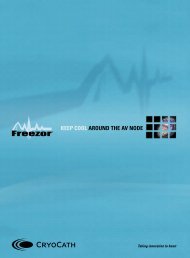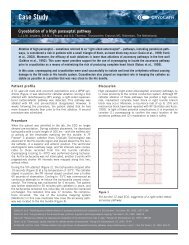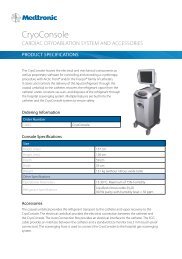View - Medtronic CryoCath LP
View - Medtronic CryoCath LP
View - Medtronic CryoCath LP
You also want an ePaper? Increase the reach of your titles
YUMPU automatically turns print PDFs into web optimized ePapers that Google loves.
1<br />
The Permanency of Pulmonary Vein Isolation Using a Balloon<br />
Cryoablation Catheter<br />
HUMERA AHMED, B.A., ∗ PETR NEUZIL, M.D., Ph.D.† JAN SKODA, M.D.,†<br />
ANDRE D’AVILA, M.D., ∗ DAVID M. DONALDSON, M.D.,‡ MARGARET C. LARAGY, B.S.,‡<br />
and VIVEK Y. REDDY, M.D. ∗ ,†<br />
From the Cardiac Arrhythmia Services of the ∗ Mount Sinai Hospital, New York, New York, USA; †Homolka Hospital, Prague, Czech<br />
Republic; and ‡Massachusetts General Hospital, Boston, Massachusetts, USA<br />
Chronic PV Isolation With the Cryoballoon. Background: Because of its technical feasibility and<br />
presumed safety benefits, balloon cryoablation is being increasingly employed for pulmonary vein (PV)<br />
isolation. While acute isolation has been demonstrated in most patients, little data are available on the<br />
chronic durability of cryoballoon lesions.<br />
Methods and Results: Twelve atrial fibrillation patients underwent PV isolation using either a 23-mm or<br />
28-mm cryoballoon. For each vein, after electrical isolation was verified with the use of a circular mapping<br />
cathether, 2 bonus balloon ablation lesions were placed. Gaps in balloon occlusion were overcome using<br />
either a spot cryocatheter or a “pull-down” technique. A prespecified second procedure was performed<br />
at 8–12 weeks to assess for long-term PV isolation. Acute PV isolation was achieved in all PVs in the<br />
patient cohort (n = 48 PVs), using the cryoballoon alone in 47/48 PVs (98%); a “pull-down” technique was<br />
employed for 5 PVs (1 right superior pulmonary vein, 2 right inferior pulmonary veins, and 2 left inferior<br />
pulmonary veins). The gap in the remaining vein was ablated with a spot cryocatheter. During the second<br />
mapping procedure, 42 of 48 PVs (88%) remained isolated. One vein had reconnected in 2 patients, while<br />
2 veins had reconnected in another 2 patients. All PVs initially isolated with the “pull-down” technique<br />
remained isolated at the second procedure.<br />
Conclusions: Cryoballoon ablation allows for durable PV isolation with the use of a single balloon. With<br />
maintained chronic isolation in most PVs, it may represent a significant step toward consistent and lasting<br />
ablation procedures. (J Cardiovasc Electrophysiol, Vol. pp. 1-7)<br />
atrial fibrillation, catheter ablation, cryoablation, pulmonary veins<br />
Introduction<br />
In the treatment of patients with paroxysmal atrial fibrillation<br />
(PAF), the foremost goal of catheter ablation is<br />
achieving permanent electrical isolation of the pulmonary<br />
veins (PVs). 1-8 The standard technique involves using a<br />
spot radiofrequency (RF) catheter to place point-by-point<br />
circumferential lesions around the PVs. While conceptually<br />
straightforward, the procedure is complicated by anatomical<br />
challenges posed by an angular left atrial–pulmonary vein<br />
(LA–PV) junction without clear demarcations, as well as<br />
catheter instability exacerbated by biological “noise” such as<br />
respiratory and cardiac motion.<br />
V. Reddy and P. Neuzil have received research grant support from Cryocath<br />
Technologies, Inc.<br />
A. d’Avila received compensation for participation on a speaker’s bureau<br />
relevant to this topic.<br />
Address for correspondence: Vivek Y. Reddy, M.D., Cardiac Arrhythmia<br />
Service, Mount Sinai School of Medicine, Zena and Michael A. Weiner<br />
Cardiovascular Institute, One Gustave L. Levy Place, Box 1030, New York,<br />
NY 10029, USA. Fax: 646-537-9691; E-mail: vivek.reddy@mountsinai.org<br />
Manuscript received 16 July 2009; Revised manuscript received 29 November<br />
2009; Accepted for publication 30 November 2009.<br />
doi: 10.1111/j.1540-8167.2009.01703.x<br />
Even when procedural success can be obtained acutely,<br />
the prevailing evidence suggests a considerable rate of PV<br />
electrical reconnection over time. This is further supported<br />
by a 15–50% rate of clinical atrial fibrillation (AF) recurrence<br />
over a given follow-up period—a rate that undoubtedly represents<br />
an underestimation of the actual incidence of electrical<br />
PV reconnection. Indeed, repeat studies have revealed that<br />
when such PAF patients do present with clinical recurrences,<br />
the most common finding is the reconnection of at least one<br />
PV. Once these gaps in the circumferential lesion sets are<br />
identified and ablated during the second procedure, patients<br />
are typically free from further clinical recurrences. Therefore,<br />
what remains elusive in patients undergoing catheter<br />
ablation for PAF is permanent PV isolation with a single<br />
procedure.<br />
As a result, various ablation technologies are being developed<br />
that aim to standardize the PV isolation procedure—<br />
foremost among these being balloon ablation catheters. 9-13<br />
To date, the largest global experience with such technology<br />
involves the cryoballoon (Cryocath Technologies, Inc.,<br />
Kirkland, Canada)—a balloon catheter designed for inflation<br />
at the PV ostium, thereby allowing for temporary occlusion<br />
of PV blood flow and circumferential ostial contact. 14 With<br />
optimal positioning, it has been demonstrated that electrical<br />
isolation can be obtained acutely with the delivery of a single,<br />
240-second lesion. 15,16<br />
Yet, because of its comparative novelty, the rate of chronic<br />
PV reconnection has not yet been examined independent<br />
of clinical outcome. Therefore, in a sequential series of
2 Journal of Cardiovascular Electrophysiology Vol. No.<br />
patients undergoing catheter cryoballoon ablation for PAF,<br />
we systematically examined the rate of PV reconnection<br />
following ablation. Because almost all patients had an implantable<br />
loop recorder, clinical outcome and symptoms were<br />
also recorded.<br />
Methods<br />
In this prospective, consecutive series of 12 patients with<br />
PAF and documented failure of at least one membrane-active<br />
antiarrhythmic drug (AAD), catheter ablation was performed<br />
using a cryoballoon catheter (23 mm or 28 mm). When necessary,<br />
an 8-mm-tip spot cryocatheter (Cryocath Technologies,<br />
Inc.) was employed to ablate gaps. All procedures were performed<br />
after obtaining written informed consent according<br />
to the institutional guidelines at Homolka Hospital, Prague,<br />
Czech Republic.<br />
Cryoballoon Ablation<br />
The cryoablation balloon system (Cryocath Technologies,<br />
Inc.) has previously been described in detail. Briefly, the system<br />
consists of a deflectable catheter with a balloon-within-aballoon<br />
design, wherein cryo-refrigerant (N 2 O) is delivered<br />
into the inner balloon. While deflated, the balloon catheter<br />
is deployed through a 12-French deflectable sheath. Once in<br />
the LA, the balloon is inflated and positioned at the PV ostium<br />
to temporarily occlude blood flow from the targeted PV<br />
(Fig. 1). After placement and occlusion have been verified<br />
with the distal injection of contrast on fluoroscopy, cryothermal<br />
energy delivery is initiated, and all tissue in contact with<br />
the balloon is ablated. When adequate tissue apposition cannot<br />
be achieved, as indicated by a leak observed on intracardiac<br />
echo (ICE; Acunav, Siemens-Ultrasound, Inc. Issaquah,<br />
WA, USA) or contrast fluoroscopy, a “pull-down” technique<br />
can be employed. The “pull-down” involves waiting for the<br />
balloon to adhere to the superior aspect of the targeted vein<br />
(typically ∼75 seconds), followed by catheter and shaft deflection<br />
to pull the balloon downward so as to achieve contact<br />
with the inferior portion of the vein, thereby eliminating the<br />
inferior gap (Fig. 2). Alternatively, a spot cryocatheter may<br />
be used to ablate gaps in circumferential lesion sets.<br />
Index Procedure<br />
Procedures were performed with either conscious sedation<br />
or general anesthesia. After standard femoral vascular access,<br />
dual transseptal punctures were performed with fluoroscopic<br />
and ICE guidance. Intravenous heparin was administered before<br />
the transseptal puncture. At the start of the procedure, a<br />
multielectrode circular mapping catheter (Lasso, Biosense-<br />
Webster, Inc., Diamond Bar, CA, USA) was used to record<br />
PV electrograms. Each cryolesion was delivered with a target<br />
time of 240 seconds; premature lesion termination occurred<br />
if there was evidence of impending phrenic nerve damage.<br />
Following each application of energy, the circular mapping<br />
catheter was used to assess for electrical isolation; accurate<br />
placement of the mapping catheter (within the first 2–3 cm<br />
of the PV antrum) was ensured with ICE guidance. After<br />
electrical isolation was demonstrated at the targeted vein, 2<br />
additional “bonus” lesions were delivered to that vein. Sixty<br />
minutes after the termination of ablation energy, intravenous<br />
isoproterenol was administered, and all veins were reassessed<br />
with the circular mapping catheter. Prior to the ablation procedure,<br />
an implantable loop recorder (Reveal XT, <strong>Medtronic</strong>,<br />
Inc., Minneapolis, MN, USA) had been placed. A relatively<br />
long baseline time for automatic detection was employed<br />
to effectively prevent overwhelming the device’s memory<br />
with short interferences, such as those caused by the pectoral<br />
muscles. In addition, patients with clinical symptoms and/or<br />
a greater frequency of automatic detection were asked to return<br />
for a greater number of office visits to allow for more<br />
frequent device interrogation. Although clinical episodes did<br />
frequently correlate with AF on the loop recorder, they often<br />
represented premature atrial couplets (PACs).<br />
EP Study/Re-Ablation<br />
All patients (n = 12) underwent a second EP study 8–<br />
12 weeks after the index ablation procedure, during which<br />
a circular mapping catheter was again used to assess for<br />
continued isolation of each PV. This prespecified procedure<br />
was performed regardless of patient symptoms. As in the<br />
index procedure, ICE imaging was employed to verify the<br />
ostial positioning of the circular mapping catheter. The implantable<br />
loop recorder was also interrogated at this time,<br />
and compared with patient reported symptoms.<br />
Figure 1. Occlusion of targeted PV with balloon cryocatheter. Fluoroscopic<br />
image depicting complete occlusion of the LSPV with the inflated balloon<br />
cryocatheter, as indicated by the absence of a peri-balloon contrast leak.<br />
The central lumen of the balloon catheter allows for the injection of contrast<br />
into the targeted PV. PV = pulmonary vein; LSPV = left superior pulmonary<br />
vein.<br />
Statistical Analysis<br />
Continuous variables are expressed as mean ± SD. The<br />
primary endpoint of the study was evidence of the resumption<br />
of PV electrical conductivity during a postprocedural EP<br />
study.<br />
The authors had full access to the data and take responsibility<br />
for its integrity. All authors have read and agree to the<br />
manuscript as written.
Ahmed et al. Chronic PV Isolation With the Cryoballoon 3<br />
Figure 2. Pull-down maneuver on fluoroscopy and intracardiac echo (ICE), with associated temperature profile. Fluoroscopic images depict the cryoballoon<br />
catheter inflated in the right inferior pulmonary vein, (A) before and (B) after a pull-down maneuver. The cryoballoon catheter has been encircled with<br />
a dashed line. Also shown are intracardiac echo images indicating the inflated cryoballoon catheter in the right inferior pulmonary vein, with color flow<br />
Doppler imaging PV blood flow (C) before and (D) after a pull-down maneuver. (E) Associated temperature recordings from a thermocouple located at the<br />
tip of the balloon catheter are shown; the blue arrow indicates the time of pull-down (187 seconds), while the blue asterisk indicates the termination of the<br />
ablation lesions.<br />
Results<br />
Patient Characteristics<br />
As displayed in Table 1, the mean age of the patient cohort<br />
(12 patients) was 54 ± 11 years and 3 (25%) were<br />
female. As determined by preprocedural echocardiography,<br />
the mean left ventricular ejection fraction and LA size were<br />
68 ± 8% and 44 ± 5 mm, respectively. Eleven (92%) patients<br />
had previously undergone implantation of a continuous loop<br />
recorder. Structural heart disease was not present in any patient,<br />
and the mean duration of PAF was 4 ± 2 years.<br />
Initial Procedure<br />
All patients underwent ablation with either the 23 mm (n =<br />
6) or the 28 mm (n = 5) balloon. In one patient, however, both<br />
balloon sizes were used due to concerns of impending phrenic<br />
nerve injury (that is decreased diaphragmatic excursion with<br />
phrenic nerve pacing during ablation of the right superior PV)<br />
with the smaller balloon during ablation of the right superior<br />
pulmonary vein (RSPV). A mean of 13 ± 2 balloon lesions<br />
were delivered per patient, with 3 ± 1 lesions delivered to<br />
each vein. Of note, only 1 bonus lesion was delivered to one<br />
right superior (due to concern of impending phrenic nerve<br />
palsy) and one right inferior PV.<br />
Acute PV isolation was achieved with the balloon catheter<br />
alone in 47 of 48 (98%) PVs following the delivery of 1 ± 1<br />
lesion (range: 1–4): one lesion-33 PVs (70%), two-9 (19%),<br />
three-2 (4%), four-3 (9%). In the remaining vein, 3 focal<br />
lesions were placed with the spot cryocatheter to achieve<br />
acute isolation. The “pull-down” technique was employed<br />
to isolate 5 of the PVs (1 RSPV, 2 right inferior pulmonary<br />
veins [RIPVs], and 2 left inferior pulmonary veins [LIPVs]).<br />
At the termination of the index ablation procedure, acute<br />
PV isolation was demonstrated in 100% of ablated veins (n =<br />
48 PVs). Regardless of the method employed to achieve acute<br />
isolation (i.e., balloon alone vs pull-down vs adjunctive spot<br />
ablation), no acute PV reconnections were noted during infusion<br />
of 20 μg/min isoproterenol at the end of the procedure.<br />
There were no acute or delayed complications.
4 Journal of Cardiovascular Electrophysiology Vol. No.<br />
TABLE 1<br />
Patient Characteristics<br />
Total Patient Cohort<br />
(n = 12)<br />
Demographic Information<br />
Age (mean ± SD) 54 ± 11<br />
Males/females 9/3<br />
Medical History<br />
Hypertension (n, %) 1 (8%)<br />
CHF (n, %) 0 (0%)<br />
Atrial flutter (n, %) 3 (25%)<br />
CAD (n, %) 0 (0%)<br />
Disease Characteristics<br />
EF (%, mean ± SD) 68 ± 8<br />
LA size (mm, mean ± SD) 44 ± 5<br />
Duration of AF (years) 4 ± 2<br />
Number of prior cardioversions 0.4 ± 0.7<br />
Medication Use<br />
No. of failed AADs (mean ± SD) 1.4 ± 0.5<br />
Amiodarone 4 (33%)<br />
Beta-blocker 3 (25%)<br />
Calcium-channel blocker 1 (8%)<br />
Propafenone 5 (42%)<br />
Sotalol 2 (17%)<br />
AADs = antiarrhythmic drugs; AF = atrial fibrillation; CAD = coronary<br />
artery disease; CHF = congestive heart failure; EF = ejection fraction;<br />
LA = left atrial; SD = standard deviation.<br />
been placed. Clinical AF recurrences were documented in 3<br />
of the 4 patients with chronic PV reconnections; 1 patient<br />
(patient 2, see Table 2) with 2 PV reconnections did not have<br />
any AF recurrences and reported no symptoms. On the other<br />
hand, 1 patient (patient 4, see Table 2) with preserved isolation<br />
of all PVs had symptomatic recurrences (presumably<br />
from an extra-PV trigger, though this did not manifest during<br />
the second procedure). One patient (patient 1) with preserved<br />
chronic PV isolation and no documented AF recurrences had<br />
brief (∼2 seconds) episodes of palpitations.<br />
On a per vein basis, the success of chronic PV isolation<br />
was 91.7% (11/12) for the LSPV, 75.0% (9/12) for the LIPV,<br />
91.7% (11/12) for the RSPV, and 91.7% (11/12) for the RIPV.<br />
Overall, the probability of PV reconnection was not related to<br />
the number of balloon ablation lesions required to isolate the<br />
target PV during the initial procedure (Table 3). Also, there<br />
was no difference in the chronic reconnection rate for PVs<br />
ablated with the 23 mm (2 of 23 PVs, 9%) or 28 mm (3 of 24<br />
PVs, 13%) balloon alone (p = 0.98). In addition, the 2 rightsided<br />
PVs that received only 1 bonus lesion during the initial<br />
procedure remained isolated. PV reconnection was observed<br />
in the one PV for which the spot catheter was required to<br />
achieve electrical isolation. Of note, for those 5 PVs initially<br />
isolated using the pull-down technique, the chronic electrical<br />
isolation rate was 5/5 (100%).<br />
Second Procedure<br />
Ten ± 2 weeks after the index ablation procedure, the repeat<br />
study revealed continued electrical isolation in 42 of 48<br />
(88%) PVs. The resumption of electrical conductivity was<br />
observed in 4 patients and 6 veins—2 patients had one reconnection<br />
each, while the other 2 had two PV reconnections<br />
each (Table 2). An analysis of focal gaps in these patients<br />
revealed one gap per vein, predominantly occurring in the<br />
inferior aspect of the vein (Figs. 3 and 4). The majority of<br />
reconnections were observed in the LIPV (3 of 6); one reconnection<br />
each was observed in the RSPV, RIPV, and left<br />
superior pulmonary vein (LSPV).<br />
Prior to the second procedure, the continuous loop<br />
recorder was interrogated for the 11 patients in whom it had<br />
Discussion<br />
Although the relationship between chronic PV reconnection<br />
and clinical outcome continues to be debated, there is<br />
increasing consensus that if safely achievable, the desirable<br />
endpoint for the ablation procedure for patients with PAF is<br />
permanent electrical PV isolation. 1-8,17-21 In practice, however,<br />
the resumption of PV electrical conductivity is common<br />
following RF catheter ablation for AF. The limited data acquired<br />
from PV re-mapping in patients with AF recurrence<br />
following cryoballoon ablation suggest that the rate of PV<br />
reconnection is similarly high.<br />
In the present study, however, a systematic assessment of<br />
lesion integrity revealed that isolation was maintained in a<br />
majority of PVs at 3 months following cryoballoon ablation<br />
for PAF. Interrogation of the continuous loop recorder in 11<br />
TABLE 2<br />
Assessment of Chronic PV Isolation at Second Procedure<br />
Patient No. LSPV LIPV RSPV RIPV Recurrences Symptoms<br />
1 + + + + No Yes<br />
2 + − + − No No<br />
3 + − + + Yes Yes<br />
4 + + + + Yes Yes<br />
5 + − + + Yes Yes<br />
6 + + + + No No<br />
7 + + + + No No<br />
8 + + + + No No<br />
9 + + + + — No<br />
10 + + + + No No<br />
11 + + + + No No<br />
12 − + − + Yes Yes<br />
Total 11/12 (92%) 9/12 (75%) 11/12 (92%) 11/12 (92%) 4/12(33%) 5/12(42%)<br />
LIPV = left inferior pulmonary vein; LSPV = left superior pulmonary vein; RIPV = right inferior pulmonary vein; RSPV = right superior pulmonary vein;<br />
– denotes PV electrical reconnection; + denotes maintained chronic isolation.
Ahmed et al. Chronic PV Isolation With the Cryoballoon 5<br />
Figure 3. Identification of a chronic focal reconnection. At the time of the remapping procedure in patient 3, a focal reconnection of the left inferior PV was<br />
seen. With the circular mapping catheter positioned in the left inferior PV, repetitive firing from the PV was observed (bracket = short nonsustained run of<br />
atrial fibrillation; arrow = a single concealed PV extrasystole; asterisk = sinus beat). The PV was then isolated with a single ablation lesion placed by a<br />
focal cryocatheter at the inferior aspect of the vein (fluoroscopy image in left anterior oblique view).<br />
of 12 patients revealed symptomatic AF recurrence in 3 of<br />
4 patients with PV reconnections and 1 of 7 without. Of interest,<br />
an examination of gaps in circumferential lesion sets<br />
for the 4 patients exhibiting PV reconnection revealed that<br />
the majority occurred in the LIPV. For all veins, one focal<br />
gap was observed per vein and, for the most part, these gaps<br />
were located in the inferior aspects of the veins. In addition,<br />
there was no difference in the rate of electrical reconnection<br />
when a 23-mm balloon catheter was employed, as opposed<br />
to the larger 28-mm balloon. Chronic isolation was maintained<br />
for all PVs in which the pull-down technique was<br />
employed.<br />
Prior Studies<br />
Three months after RF ablation in patients with paroxysmal<br />
or persistent AF, Cappato et al. documented an overall<br />
rate of PV electrical reconnection approaching 80%, despite<br />
the attainment of acute ostial isolation in 96% of targeted<br />
veins. 22 In a similar series, Nanthakumar et al. explored the<br />
rate of PV reconnection at 3 months in 15 patients with symptomatic,<br />
recurrent AF following an index ablation procedure<br />
performed with either RF or cryo spot ablation. 23 Resumption<br />
of electrical conductivity was observed in ≥ 2 veins in<br />
all patients.<br />
Similar data for patients with documented AF recurrence<br />
following cryoballoon ablation were found in 14 patients<br />
undergoing a repeat ablation procedure for symptomatic, recurrent<br />
AF: PV electrical reconnection was observed in ≥ 1<br />
PV per patient, with the majority of reconnections observed<br />
in the left-sided PVs. 24 Following a second procedure in 8<br />
of the patients, during which only the PVs were re-isolated,<br />
the patients were free from AF during the follow-up period<br />
of 8 months. These results confirm that chronic clinical success<br />
is indeed feasible, albeit in this series requiring a high<br />
incidence of a second procedure. This may be due to the nature<br />
of cryoablation, which attains a maximal rate of cooling<br />
after the delivery of an initial, priming lesion to a region of<br />
tissue. 25 This implies improved energy transduction with the<br />
delivery of subsequent lesions—introducing the notion that<br />
the high rate of chronic procedural success in our series may<br />
be due, at least in part, to the delivery of the 2 bonus lesions<br />
once isolation had been verified.<br />
While these studies established the virtual universality<br />
of chronic PV reconnection following the use of both conventional<br />
and newer, balloon-based methods of catheter ablation,<br />
the relationship between long-term clinical success<br />
and maintained PV isolation remains debated. In a pivotal<br />
study, however, Verma et al. examined PV conduction at 3<br />
months following an index procedure with spot RF ablation,<br />
in a series of AF patients at varying levels of clinical<br />
efficacy. 26 They found that the majority (86%) of patients<br />
TABLE 3<br />
Breakdown of Chronic PV Isolation, Based on the Number of Lesions<br />
Required for Isolation During the Initial Procedure<br />
Chronic Isolation<br />
No. of Lesions Total Chronic<br />
Required for Isolation Veins YES NO Success Rate (%)<br />
Figure 4. Location of chronic focal PV reconnections. A schematic representation<br />
of the pulmonary veins indicating the location of chronic gaps in<br />
isolation, as well as the associated interval between the local atrial and PV<br />
potentials.<br />
4 3 3 0 100%<br />
3 2 1 1 50%<br />
2 9 9 0 100%<br />
1 33 29 4 88%<br />
Total 47 42 5 89%<br />
For those veins in which acute isolation (as observed in the second procedure)<br />
was achieved with the balloon catheter only, the rate of successful<br />
chronic PV isolation is broken down by the number of ablation lesions required<br />
to obtain acute isolation.
6 Journal of Cardiovascular Electrophysiology Vol. No.<br />
in sinus rhythm off of all AADs had no PV reconnections;<br />
in contrast, all patients with recurrent AF despite the use<br />
of AADs had reconnections in ≥1 PV—suggesting a direct<br />
relationship between PV reconnection and the degree of clinical<br />
success following an index ablation procedure. This is<br />
confirmed in our own experience, given that of the 4 patients<br />
with symptomatic AF recurrences at 3 months, only 1 did<br />
not have reconnections in ≥1PV.<br />
Present Study<br />
While the limited patient number precludes definitive conclusions<br />
from this study, the rate of chronic PV isolation was<br />
88% at 3 months following an index procedure for PAF, with<br />
an associated clinical success rate of 67%. Furthermore, it<br />
was demonstrated that this relatively high rate of chronic procedural<br />
success could be obtained in most patients with a single<br />
balloon—whether the 23 mm or the 28 mm balloon—as<br />
no difference in chronic success rates was observed between<br />
the 2 catheter sizes.<br />
An analysis of the location of gaps in reconnected PVs<br />
revealed that the majority occurred in the LIPV; for all veins,<br />
gaps were predominantly found in the inferior region of<br />
the vein. This study also revealed chronic success in PVs<br />
for which the pull-down technique was employed. Both of<br />
these results are consistent with the limitations of the balloon<br />
catheter itself—namely, the inability to conform to the highly<br />
variable PV anatomy. This results in inferior gaps to occlusion,<br />
which are particularly troublesome during ablation of<br />
the ovaloid left-sided PVs. Rapid temperature decreases observed<br />
with the pull-down technique suggest its utility in<br />
closing inferior leaks, and thereby maximizing the delivery<br />
of energy to the PV ostium.<br />
Limitations<br />
The second EP study was performed 8–12 weeks after the<br />
index ablation procedure, leaving the possibility that further<br />
reconnections may have been observed had the intervening<br />
period been greater. However, our clinical experience would<br />
indicate that PAF patients with recurrent AF are typically<br />
clinically quiescent for several weeks, and begin to exhibit<br />
clinical symptoms between 3 and 4 weeks of the initial procedure.<br />
This has given us the impression that PV reconnection,<br />
when observed, likely occurs within 1 month after the index<br />
ablation procedure. As such, the 8–12 week window employed<br />
in this study allows for an accurate representation<br />
and analysis of long-term PV reconnection.<br />
It is unclear from this study whether bonus ablation lesions<br />
are necessary to achieve permanent PV isolation. However,<br />
this was addressed in an earlier series of 7 patients undergoing<br />
cryoballoon ablation, but without the delivery of bonus<br />
ablation lesions. In this series, the rate of chronic PV isolation<br />
(at 3 months during a prespecified second procedure<br />
regardless of clinical symptoms) was only 14%. However,<br />
this anecdotal experience was limited by the fact that the<br />
series had been performed early in our experience with the<br />
cryoballoon catheter. But based on this earlier experience,<br />
and the present more favorable experience when placing 2<br />
bonus lesions/PV, our current clinical practice is to place 2<br />
bonus lesions per PV.<br />
Definitive conclusions are also limited by the relatively<br />
small number of patients included in this study. However,<br />
the complexity of the study design—that is, a prespecified<br />
second EP study regardless of symptomatology after the first<br />
procedure—was a limiting factor in enrollment. Further randomized<br />
studies are required to confirm our results, as well<br />
as to determine whether it would be equally effective to deliver<br />
only one bonus lesion (or even no bonus lesion) to each<br />
PV.<br />
Conclusion<br />
A high rate of chronic PV isolation can be achieved with<br />
balloon cryoablation. This may play an important role in<br />
obtaining the ultimate, albeit somewhat elusive goal of consistently<br />
achieving permanent isolation with a single procedure.<br />
References<br />
1. Haïssaguerre M, Jais P, Shah DC, Garrigue S, Takahashi A, Lavergne T,<br />
Hocini M, Peng JT, Roudaut R, Clémenty J: Electrophysiological end<br />
point for catheter ablation of atrial fibrillation initiated from multiple<br />
pulmonary venous foci. Circulation 2000;101:1409-1417.<br />
2. Jais P, Weerasooriya R, Shah DC, Hocini M, Macle L, Choi K-J,<br />
Scavee C, Haïssaguerre M, Clémenty J: Ablation therapy for atrial<br />
fibrillation (AF): Past, present and future. Cardiovasc Res 2002;54:337-<br />
346.<br />
3. Chen S-A, Hsieh M-H, Tai C-T, Tsai C-F, Prakash VS, Yu W-C, Hsu<br />
T-L, Ding Y-A, Chang M-S: Initiation of atrial fibrillation by ectopic<br />
beats originating from the pulmonary veins: Electrophysiological characteristics,<br />
pharmacological responses, and effects of radiofrequency<br />
ablation. Circulation 1999;100:1879-1886.<br />
4. Marrouche NF, Dresing T, Cole C, Bash D, Saad E, Krzysztof B, Pavia<br />
SV, Schweikert R, Saliba W, Abdul-Karim A, Pisano E, Fanelli R,<br />
Tchou P, Natale A: Circular mapping and ablation of the pulmonary<br />
vein for treatment of atrial fibrillation: Impact of different catheter<br />
technologies. J Am Coll Cardiol 2002;40:464-474.<br />
5. Oral H, Knight BP, Tada H, Ozaydin M, Chugh A, Hassan S, Scharf<br />
C, Lai SWK, Greenstein R, Pelosi F, Strickberger A, Morady F: Pulmonary<br />
vein isolation for paroxysmal and persistent atrial fibrillation.<br />
Circulation 2002;105:1077-1081.<br />
6. Gerstenfeld EP, Guerra P, Sparks PB, Russo AM, Nayak H, Lin D, Pulliam<br />
W, Siddique S, Marchlinski FE: Clinical outcome after radiofrequency<br />
catheter ablation of focal atrial fibrillation triggers. J Cardiovasc<br />
Electrophysiol 2001;12:900-908.<br />
7. Pappone C, Rosanio S, Augello G, Vicedomini G, Mazzone P, Gulletta<br />
S, Gugliotta F, Pappone A, Santinelli V, Tortoriello V, Sala S, Zangrillo<br />
A, Crescenzi G, Benussi S, Alfieri O: Mortality, morbidity, and<br />
quality of life after circumferential pulmonary vein ablation for atrial<br />
fibrillation. J Am Coll Cardiol 2003;42:185-197.<br />
8. Ouyang F, Bansch D, Ernst S, Schaumann A, Hachiya H, Chen M,<br />
Chun J, Falk P, Khanedani A, Antz M, Kuck K-H: Complete isolation<br />
of left atrium surrounding the pulmonary veins: New insights from<br />
the double-lasso technique in paroxysmal atrial fibrillation. Circulation<br />
2004;110:2090-2096.<br />
9. Natale A, Pisano E, Shewchik J, Bash D, Fanelli R, Potenza D, Santarelli<br />
P, Schweikert R, White R, Saliba W, KKanagaratnam L, Tchou P,<br />
Lesh M: First human experience with pulmonary vein isolation using<br />
a through-the-balloon circumferential ultrasound ablation system for<br />
recurrent atrial fibrillation. Circulation 2000;102:1879-1882.<br />
10. Saliba W, Wilber D, Packer D, Marrouche N, Schweikert R, Pisano E,<br />
Shewchik J, Bash D, Fanelli R, Potenza D, Santarelli P, Tchou P, Natale<br />
A: Circumferential ultrasound ablation for pulmonary vein isolation:<br />
Analysis of acute and chronic failures. J Cardiovasc Electrophysiol<br />
2002;13:957-961.<br />
11. Keane D: New catheter ablation techniques for the treatment of cardiac<br />
arrhythmias. Card Electrophysiol Rev 2002;6:341-348.<br />
12. Reddy VY, Neuzil P, Themisotoclakis S, Bonso A, Rossillo A, Raviele<br />
A, Saliba W, Schwiekert R, Ernst S, Kuck K-H, Ruskin J, Natale A:<br />
Long-term single-procedure clinical results with an endoscopic balloon<br />
ablation catheter for pulmonary vein isolation in patients with atrial<br />
fibrillation. Circulation 2006;114:II-747.<br />
13. Wright M, Haissaguerre M, Knecht S, Matsuo S, O’Neill MD, Nault<br />
I, Lellouche N, Hocini M, Sacher F, Jais P: State of the art: Catheter<br />
ablation of AF. J Cardiovasc Electrophysiol 2008;19:583-592.
Ahmed et al. Chronic PV Isolation With the Cryoballoon 7<br />
14. Siklody CH, Minners J, Allgeier M, Allgeier H-J, Jander N, Weber R,<br />
Schiebeling-Romer J, Neumann F-J, Kalusche D, Arentz T: Cryoballoon<br />
pulmonary vein isolation guided by transesophageal echocardiography:<br />
Novel aspects of an emerging ablation technique. J Cardiovasc<br />
Electrophysiol 2009;20:1197-1202.<br />
15. Reddy VY, Neuzil P, Pitschner HF, Kuniss M, Kralovec S, Kanova<br />
M, Laragy M, Mihalik TA, Taborsky M, Ruskin JN: Clinical experience<br />
with a balloon cryoablation catheter for pulmonary vein isolation<br />
in patients with atrial fibrillation: One-year results. Circulation<br />
2005;112:II491-492.<br />
16. Chun KRJ, Furnkranz A, Metzner A, Schmidt B, Tilz R, Zerm T, Koster<br />
I, Nuyens D, Wissner E, Ouyang F, Kuck KH: Cryoballoon pulmonary<br />
vein isolation with real-time recordings from the pulmonary veins. J<br />
Cardiovasc Electrophysiol 2009;20:1203-1210<br />
17. Wittkampf FH, Vonken E, Derksen R, Loh P, Velthuis B, Wever<br />
EFD, Boersma LVA, Rensing BJ, Cramer M-J: Pulmonary vein ostium<br />
geometry analysis by magnetic resonance angiography. Circulation<br />
2003;107:21-23.<br />
18. Kato R, Lickfett L, Meininger G, Dickfield T, Wu R, Juang G, Angkeow<br />
P, LaCorte J, Bluemke D, Berger R, Halperin HR, Calkins H: Pulmonary<br />
vein anatomy in patients undergoing catheter ablation of atrial<br />
fibrillation: Lessons learned by use of magnetic resonance imaging.<br />
Circulation 2003;107:2004-2010.<br />
19. Ahmed J, Sohal S, Malchano ZJ, Holmvang G, Ruskin JN,<br />
Reddy VY: Three-dimensional analysis of pulmonary venous ostial<br />
and antral anatomy: Implications for balloon catheter-based pulmonary<br />
vein isolation. J Cardiovasc Electrophysiol 2006;17:251-<br />
255.<br />
20. Kanj MH, Wazni OM, Natale A: How to do circular mapping catheterguided<br />
pulmonary vein antrum isolation: The Cleveland Clinic approach.<br />
Heart Rhythm 2006;3:866-869.<br />
21. Pratola C, Baldo E, Notarstefano P, Toselli T, Ferrari R: Radiofrequency<br />
ablation of atrial fibrillation: Is the persistence of all intraprocedural targets<br />
necessary for long-term maintenance of sinus rhythm Circulation<br />
2008;117:136-143.<br />
22. Cappato R, Negroni S, Pecora D, Bentivegna S, Lupo PP, Carolei A,<br />
Esposito C, Furlanello F, Ambroggi LD: Prospective assessment of<br />
late conduction: Recurrence across radiofrequency lesions producing<br />
electrical disconnection at the pulmonary vein ostium in patients with<br />
atrial fibrillation. Circulation 2003;108:1599-1604.<br />
23. Nanthakumar K, Plumb VJ, Epstein AE, Veenhuyzen GD, Link D,<br />
Kay GN: Resumption of electrical conductivity in previously isolated<br />
pulmonary veins: Rationale for a different strategy Circulation<br />
2004;109:1226-1229<br />
24. Neuser H, Schneider MAE, Fröhner S, Bohm C, Koller ML, Kerber S,<br />
Schumacher B: Atrial fibrillation relapse after pulmonary vein isolation<br />
with cryo technique: Is repeated cold isolation medically useful<br />
Presented at the German Cardiac Society meeting 2008.<br />
25. Bradley HJ, Saarel EV, Terrill M, Terrill M, Gutierrez L, Kelly M,<br />
Etheridge SP: The priming effect in catheter cryoablation: Are all<br />
freezes the same Heart Rhythm 2008;5:S143.<br />
26. Verma A, Kilicaslan F, Pisano E, Marrouche NF, Fanelli R, Brachmann<br />
J, Geunther J, Potenza D, Martin DO, Cummings J, Burkhardt D,<br />
Saliba W, Schweikert RA, Natale A: Response of atrial fibrillation to<br />
pulmonary vein antrum isolation is directly related to resumption and<br />
delay of pulmonary vein conduction. Circulation 2005;112:627-635.




